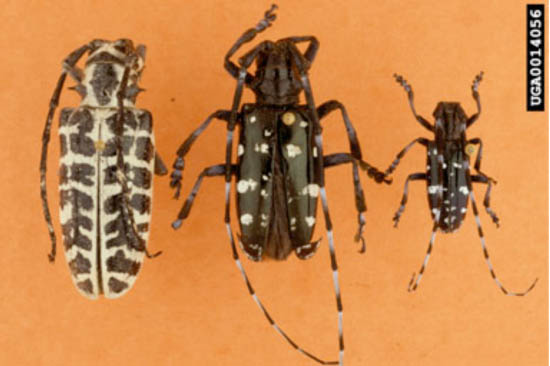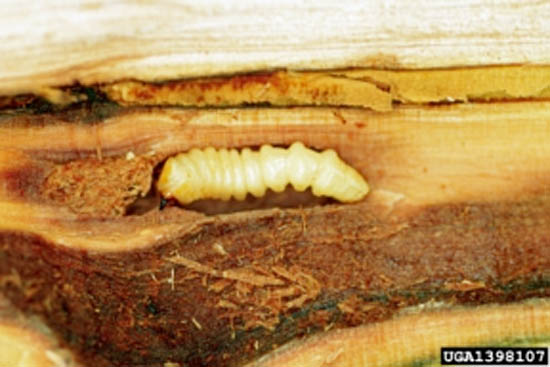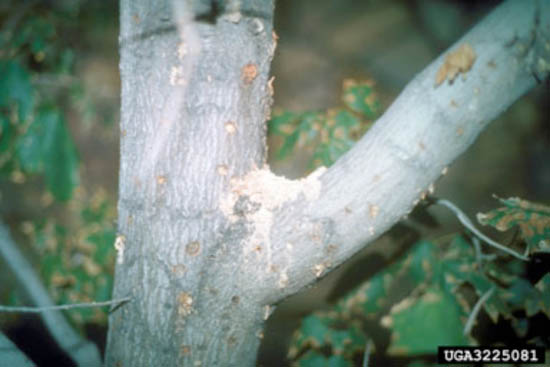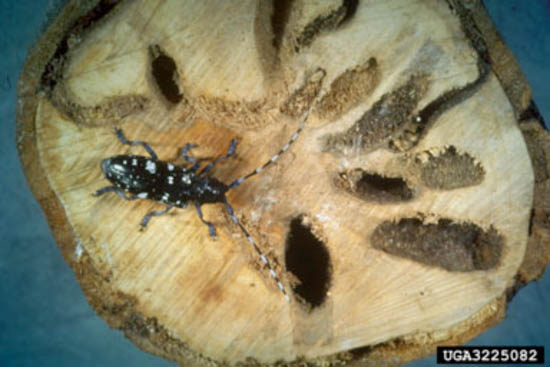Issue 12, July 17, 2009
Invasive Species Spotlight--Asian Longhorned Beetle
The Asian longhorned beetle is an exotic pest that threatens a number of hardwood trees in North America. It is believed that this insect arrived in North America in wooden packing material from China.
This woodboring beetle goes through four life stages: egg, larva, pupa, and adult. The eggs are laid by adult beetles on the bark of living trees. A single female can lay up to 90 a year with each egg being placed in its own site. Eggs are encased in a brownish protective secretion about ¼ inch in diameter. The larva emerges from this egg site in about 10 to 15 days and begins burrowing into the tree's bark. They begin by feeding on the sapwood around the tree but later feed on the heartwood and overwinter in there. In the springtime they continue feeding until they begin their pupal stage. This may last over a week as it begins transformation into its adult form.
Adults are generally present from June through October. They can range in size from 1 to 1 ½ inches long. They are black with white specks on its elytra (wing covers) and have long white and black banded antennae. Females tend to be a bit large than the males.

From Left to Right: Cottonwood Borer (a similar looking beetle native to the US), Female ALB, Male ALB.
The greatest damage to trees is caused by the larva as they tunnel through the living tissues of the phloem and xylem. Ultimately the tree loses its ability to transport water and nutrients to its canopy and roots and dies. Because the ALB can be quite large it can also weaken the structural integrity of a tree.

Larva (Picture taken by: ALB Steven Katovich, USDA Forest Service)
Visual symptoms of an infested tree can include the accumulation of frass on tree branch collars below holes cause by exiting beetles. Exit holes can be quite large and distinct from other longhorned beetles; up to ½ inch in diameter and almost perfectly circular. Adult beetles can also be found chewing on the veins of leaves leaving the other leaf tissues intact. Egg sites can also be an important visual clue to their presence.

Frass and sawdust left below holes.
Asian Longhorned Beetles have a wide range of preferred host trees. Most studies show that they prefer maple trees of any species. Its other top choices include: birch, horse chestnut, poplar, willow, elm, ash, hackberry, sycamore, mountain ash, and London plane tree as well as many others.

Damaged heartwood and adult beetle
The Asian longhorned beetle was first identified in New York City in 1996. Two years later it was detected in a Chicago neighborhood and in 2002 in New Jersey. When entomologists and resource managers from numerous organizations first learned of the destructive potential of the insect they quickly made plans to try and eradicate it. The first steps were to survey for damage and then to establish quarantine zones. Surveys were done using aerial lifts and tree climbers to thoroughly inspect all tree parts. Infested trees were removed and destroyed. Non-infested trees within the quarantine zones were treated with a systemic insecticide as a precautionary approach. After a long battle with this invasive insect, Illinois declared eradication in 2008.
Four months after the beetle was declared eradicated from the Chicago-land area it was found in Deerfield in August 2008. However, extensive survey efforts have not found any infestation or other signs of this invasive pest. If you suspect the Asian Longhorned Beetle anywhere in Illinois please contact: The Illinois Department of Agriculture at 1-800-641-3934.
Photos courtesy of www.bugwood.org.--Kelly Estes
Author:
Kelly Estes